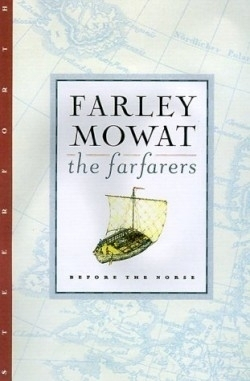The Farfarers
Before the Norse
In his unerringly superlative writing, Mowat is once again standing the archaeological world on end. Almost thirty-five years after releasing his controversial theory that the Norse were the first Europeans to discover the North American continent (Westviking, 1965), Mowat has pieced together enough evidence to suggest that he was wrong. Not wrong in terms of the dates and events of the Norse, but in saying the Norse were the first Europeans. In The Farfarers, he contends that a people whom their contemporaries called Albans-natives of the Scottish Highlands-journeyed to the North American continent before (and partially because of) the Norse.
Describing the archeological enigmas of ancient stone foundations and massive stone cairns found in the Canadian Arctic he investigated in 1966, Mowat piques one’s interest with just enough details before turning aside, stating “telling the tale backwards as it actually unravelled is not the way the old story tellers would have done it. They always began at the beginning.” He does; starting with the first of many historical vignettes about a people who have built a vessel named “Farfarer” and the logical steps of development to bring about the first boats. This in turn, Mowat theorizes, allowed people to settle the northern reaches of Britain and survive in an otherwise inhospitable place-mainly because they could sustain themselves on the bounty of the surrounding waters.
From here, Mowat describes an interesting cause and effect course of events: trade expeditions to southern areas resulted in the harvesting of the much-in-demand walrus tusks in order to obtain prized items such as bronze tools and exotic jewelry. When walrus became scarce off the shores of Orkney and Shetland Islands, the Albans went westward to the shores of Ireland and, after a time, followed the flight of migratory birds to what is now Iceland. The Albans did not migrate, but rather remained at their homes in northern Britain. The men would sail to their new hunting grounds, collect tusks, hides and fat for fuel at home and return home before continuing south to trade or having traders come north. Norse invaders, however, came to plunder and pillage the British Isles, forcing the Northern Islanders-the Albans-to flee to the only area available: Iceland. From here, trade continued with continental European merchant mariners until the Norse looked further west for more plunder, pushing the Albans westward again. In due succession, the Albans would flee first to Greenland, then onward to Labrador and later, in search of new hunting grounds and a more secure home away from the westward-seeking Norse, to Newfoundland.
The latter part of the story focuses on following to conclusion several lines of thought developed earlier. Mowat once again draws on scant evidence to conclude the following: The Norse failed to establish themselves in Labrador and Newfoundland because wary Albans, Tunits and Beothuks were better prepared to defend their land against further Norse invasions. A 300-year “gap” in Greenland’s Christianity occurred because of the attack of the southern settlement by both the anti-theocratic settlement to the north and a declining interest in Greenland by Norway. It is only dealing with the “disappearance” of Beothuk and Tunit cultures as well as the people of Alba-in-the-West that Mowat is “sufficiently confident of [his suppositions] to dispense with the usual continuous barrage of qualifications.” What he logically concludes is that these different cultures did not disappear, but instead intermingled with newcomers to create the new “native” populations of the eastern regions of Canada.
Throughout this captivating work, Mowat strikes an interesting balance in describing his own exploratory journeys, the physical evidence found in various locations, the scant references found in historical documents and his own historical vignettes which bring the story to life. The over all effect gives the reader a logical historical framework as well as a clear picture of what Mowat believes occurred. Refreshingly, Mowat is first to admit (several times throughout the course of the book, in fact), that what he has written has been pieced together loosely from a dearth of historical writings-and these from later time periods-which only allude to the presence of the Albans. “The plain fact is that my book makes no pretence at being history in the academic sense. It is the story of a vanished people: their successes, failures, and ultimate fate. I believe it to be a true story.”
What a story! After more than thirty years of research, his theory of the Albans flies in the face of the now conventionally accepted belief-ironically developed by Mowat himself that the Norse were first to cross over the Western Ocean. Those who know his writings will surely find The Farfarers the most intriguing and fascinating work that Mowat has ever put forward. For those who have never had the pleasure of engrossing themselves in an historical account by Mowat, an unforgettable experience in learning history in an entertaining way awaits them.
Reviewed by
Nelly Heitman
Disclosure: This article is not an endorsement, but a review. The publisher of this book provided free copies of the book to have their book reviewed by a professional reviewer. No fee was paid by the publisher for this review. Foreword Reviews only recommends books that we love. Foreword Magazine, Inc. is disclosing this in accordance with the Federal Trade Commission’s 16 CFR, Part 255.

